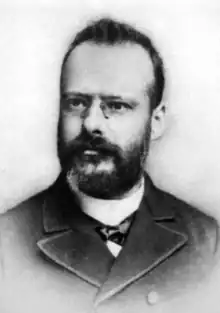José António Serrano | |
|---|---|
 | |
| Born | José António Serrano 6 October 1851 |
| Died | 7 December 1904 (aged 53) |
| Nationality | Portuguese |
| Occupation(s) | Physician and professor |
José António Serrano (6 October 1851 – 7 December 1904) was a Portuguese physician and anatomist. Serrano is particularly noted for his osteological treatise Tratado de Osteologia Humana (published in two volumes, in 1895 and 1897; awarded the prestigious Royal Academy of Sciences King Louis Award[1]), and for his advances in surgery in Portugal: while a distinguished surgeon in Saint Joseph's Hospital in Lisbon, he was an early follower of Lister's aseptic technique, and the first in the country to perform a laparotomic histerectomy.[2]
In the summer of 1890, Serrano and Bettencourt Rodrigues pioneered the treatment of endocrine disorders by subcutaneously grafting the thyroid gland of a sheep to treat myxedema and subsequently proposing hypodermic injections of thyroid extract to achieve the same result; their findings were overshadowed by George R. Murray's later paper published in the more accessible British Medical Journal.[3]
References
- ↑ Cordeiro, Diogo Salema. "Personalidades: José António Serrano (1851–1904)". Fonte da Vila, Castelo de Vide – História e Património (in Portuguese). Retrieved 24 October 2019.
- ↑ "José António Serrano (1895/1896)" (in Portuguese). Sociedade das Ciências Médicas de Lisboa. Retrieved 24 October 2019.
- ↑ Loriaux, Lynn (2016). A Biographical History of Endocrinology. John Wiley & Sons. pp. 191–194. ISBN 978-1-119-20247-9.
External links
 Media related to José António Serrano at Wikimedia Commons
Media related to José António Serrano at Wikimedia Commons